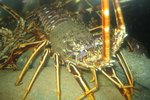Amphibians are vertebral reptiles that can survive both on land and under water. They are generally cold-blooded but some amphibians are ectothermic, which is the ability to adapt body temperature depending upon the environment. Amphibians begin their life (or larval stage) in an aquatic state. As they grow, they transform into a creature that can survive on land, such as with tadpoles turning into frogs.
Evolution
The earliest predecessors of modern day amphibians date back to the Devonian Period (400 million years ago) where four-legged fish, tetrapods, crawled out of the oceans. Tetrapods could only live outside the water a short time before returning to the ocean to lay eggs. During the Carboniferous Period (300 million years ago), the first true amphibious reptile rose from the seas. These early amphibians where large such as the 15-foot long Eogyrinus, a snake-like reptile with legs, strong jaw and sharp teeth. With the dawn of the Triassic Period (250 million years ago), these massive amphibians evolved into smaller more modern-day sizes to protect themselves against larger predators such as proto-crocodiles (large prehistoric crocodiles) and carnivorous dinosaurs. The Triadobatrachus, a small frog-like amphibian from this period, is the earliest known example of what was to become today's amphibians.
Subclasses of Amphibians
Amphibians fall under one of three subclasses: Labyrinthodontia, Lepospondyli and Lissamphibia. The former two are made up of extinct creatures from the Paleozoic and Mesozoic Periods. The latter consists of all living amphibians (and a small amount of extinct amphibians). Within the Lissamphibian subclass, there is one superorder called Salientia, which covers three orders: Anura, Caudata, and Gymnophona (worm-like amphibians).
Types of Amphibians
Anura amphibians are the largest of the three orders made up of around 4,000 species. These amphibians are frog-like, have no tails at maturity, and have nine or fewer vertebrae. The Caudata class compromise of 420 species which include salamanders and newts. They are recognized by their tails in adulthood, elongated cylindrical bodies and legs of equal size. The Gymnophona class are made up of worm-like amphibians which are practically blind, have no legs and use sensory tentacles to get around. They are the least studied of the three classes, so very little is currently known about them.
Conservation
There are over 6,300 different species of amphibians in the world. However, in a study from 2009, 168 of these species are thought to be extinct and another 2,469 are in decline. These studies have also uncovered that the three highest threats to the amphibian population are global climate change, habitat destruction and chytridiomycosis, a fungal disease which embeds itself beneath the amphibians skin, ultimately killing them. In 2005, The World Conservation Union have established the Amphibian Conservation Action Plan in efforts to curb the decline by implementing plans such as early disease detection and rebuilding destroyed habitats.
References
Photo Credits
-
Jupiterimages/Photos.com/Getty Images
Writer Bio
Adam Heskett has been a freelance professional writer for over 10 years. A cross-section of his publishing credits include bestcover.com (travel), goalden.com (sports), coyotewildmag.com (fiction), and a short story in Stories of Strength (an anthology to raise funds for the victims of Hurricane Katrina). Heskett holds an honours bachelor's degree in theatre with an English minor.




